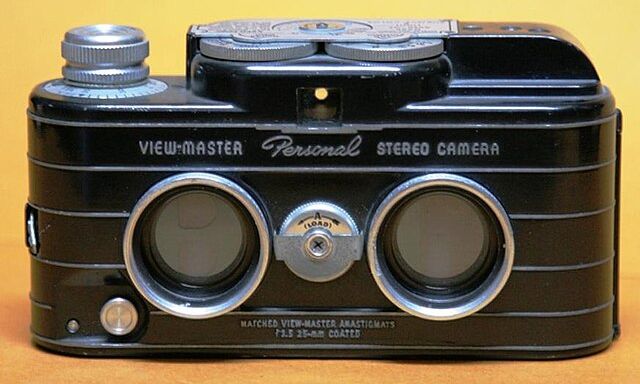
The image above is from the Wikimedia Commons, licensed under the Creative Commons Attribution-Sharealike 4.0 International License, and is thus available for your use under the same terms.
Its author is OppidiumNissenae.
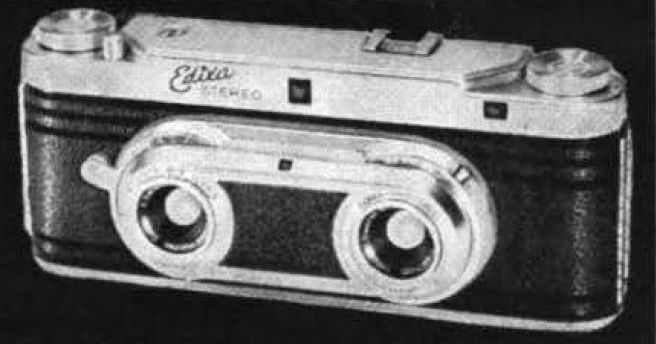
The image at right shows another rangefinder camera using 35mm film. However, it is no mere imitation of the Leica, as this camera by Edixa has a very obvious special feature: two lenses, separated by approximately the same distance as the human eyes, in order to take stereo pictures for a three-dimensional effect.
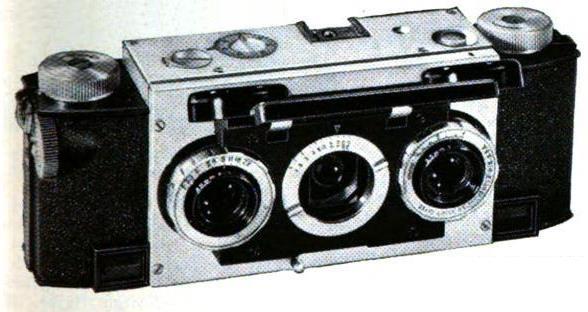
One of the most popular cameras of this type was the Stereo Realist camera, shown at left. Note that it has three lenses, not just two, side by side in the front; in a 3-D camera, one can employ the twin-lens reflex principle, and yet not have any parallax error!
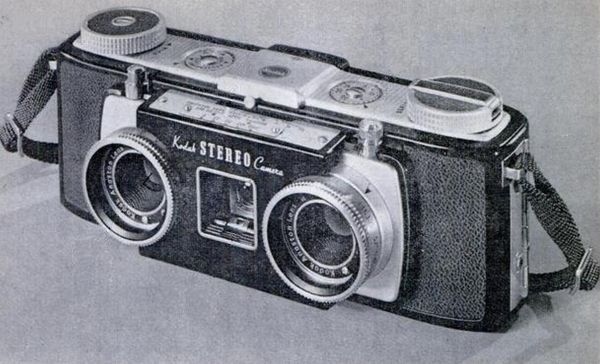
Kodak even made one that was compatible with it, shown at right.
 |
The image above is from the Wikimedia Commons, licensed under the Creative Commons Attribution-Sharealike 4.0 International License, and is thus available for your use under the same terms. Its author is OppidiumNissenae. |
There was also the View-Master® Personal Stereo Camera, shown at left. Rather than requiring people to purchase 16mm film to use it, it was designed to expose only half of the film when taking pictures, and to change from the top half to the bottom half when reversing the direction of film travel to take the next set of pictures; this way, it could use common, ordinary 35mm film.
Normal 35mm motion picture cameras advance the film by four perforations for each frame, allowing a frame of 24mm by 18mm. The 36mm by 24mm frame introduced by Leica for 35mm still photography required advancing the film by eight perforations between each shot.
The format used by the Stereo Realist camera involved having each image consume five perforations. In that way, the left and right images of a pair could have two images between them belonging to other stereo pairs, and be about the right distance apart on the film to be behind the two lenses separated by the distance between the two eyes of a human being. This meant that a frame on the film was nearly square.
The distance between perforations on 35mm film is 4.75mm, which gives 1mm between frames in a 35mm movie, but 2mm between 35mm still photographs. If that could be trimmed down to 0.75mm, then the Stereo Realist format would allow for a nearly square frame of 23mm by 24mm. An image on Wikipedia of a strip of film exposed on such a camera, however, shows that instead the frame size is 22.5mm by 24mm.
Actually, the perforation spacing of 35mm film is 4.7625mm... or exactly 3/16 of an inch; as befits a format that started life as being 1 3/8 inches wide rather than 35mm wide.
Note that 15 times 4.75mm is 7.125 cm, or just over 2.8 inches, somewhat larger than the 2 1/2 inches often quoted as the standard interocular distance. The separation between lenses on a Stereo Realist camera, however, is not 71.25 mm but 69.28 mm. about 2.72756 inches. This could be achieved by curving the film between the two areas where it is exposed, but the lenses should be slightly closer together than the images on the film so that they are both covering the same area between the lenses.
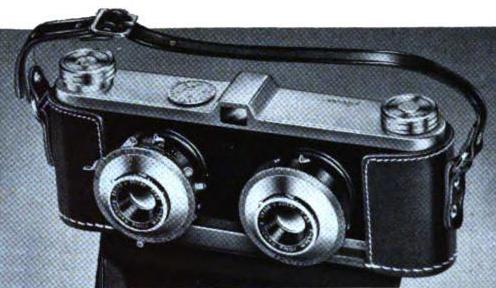
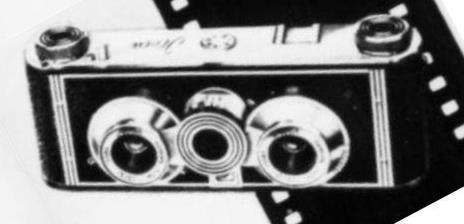
The image at left of an Iloca stereo camera introduces it as the new Iloca Stereo camera, from 1951, and so I had hoped that this is an image of the earlier version that used seven perforations per frame instead of switching to follow the Stereo Realist image format. The image on the right of a different model is from a later advertisement, but only from 1952. Checking into the matter, I have found that indeed the one on the left uses the European 7p format, and the one on the right is the second version that had already switched over to the 5p format of the Stereo Realist.
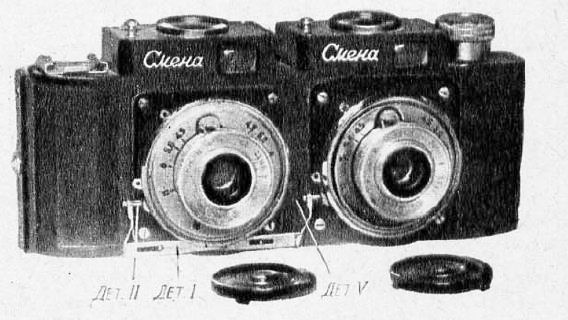
Even in the Soviet Union, a stereo camera, the Stena, was made, as shown at right.
And below is a British 3-D camera, which billed itself as the only popular-priced 3-D camera in the world,
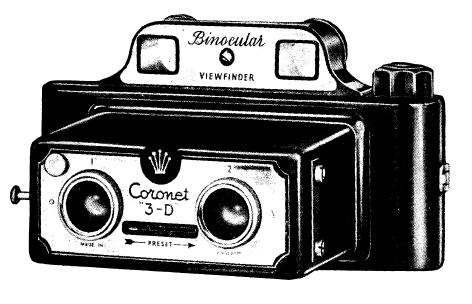
despite taking pictures on 127 film rather than 35mm film.
Note that it had a binocular viewfinder, presumably allowing one to view the scene being photographed in three dimensions.
Many other companies made stereo cameras for a time; and, of course, such cameras are not new, as the Stereopticon for viewing three-dimensional stereo images dates back to the nineteenth century.
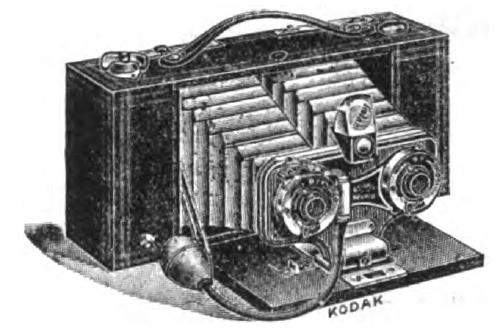
Here, for example, is the No. 2 Stereo Brownie as an example of an early stereoscopic 3-D camera.
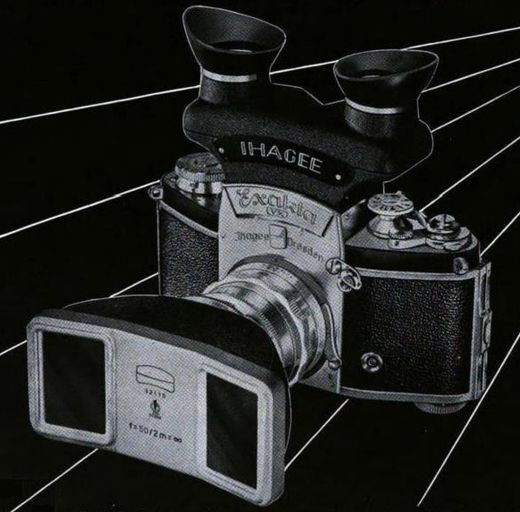
On the other hand, another way to save money when plunging into 3-D photography would be to obtain a 3-D adapter for your existing camera. Such adapters were available for a number of cameras; at left we see one made by Exakta specifically for their own 35mm SLR cameras, which also offered an attachment for the reflex screen allowing the shot to be taken to be viewed in three dimensions.
Here is a diagram showing the various ways in which the images from stereo pairs have been, or can be, placed on 35mm film.
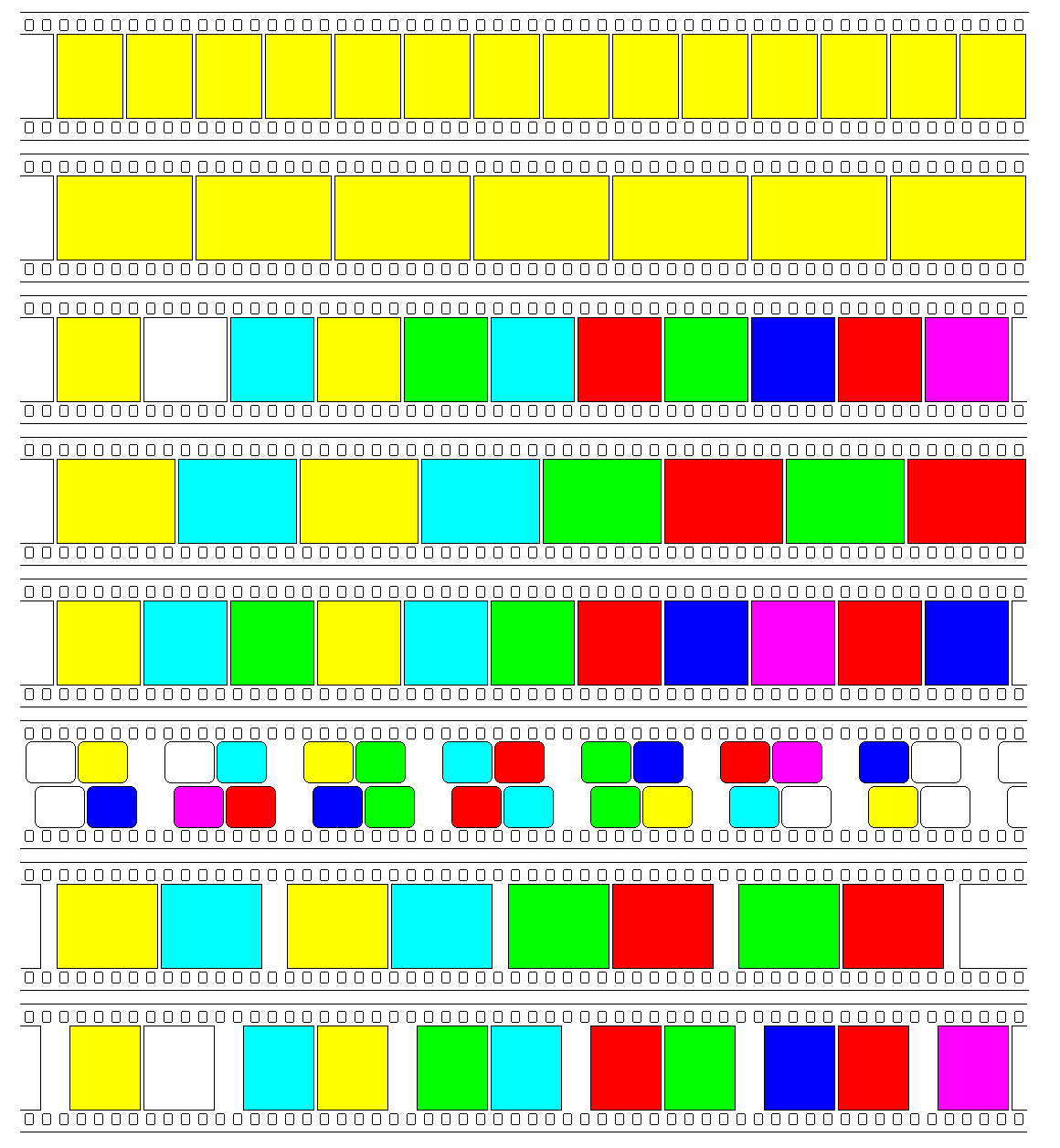
First, the top row shows the four-perf format of 35mm movie film; and the second row shows the eight-perf format of 35mm still picture film for comparison.
The third row shows the format used by the Stereo Realist camera. The two frames of a stereo image are displaced by three (five-perf) frames, with two frames between them. So after one stereo pair is photograph, the film is advanced by two frames. Since two and three are relatively prime, stereo pairs don't collide with each other, the only issue is that one frame is wasted at the start of a film (and presumably one at the end as well).
The fourth row shows the format used by some early European stereo cameras. Here, each image frame has seven perforations of space, so there is only one frame between the two frames of a stereo pair. Thus, the trick used for the Stereo Realist format cannot be made to work; instead, the film is advanced alternately one frame and three frames, in the sequence 1,3,1,3,1,3... after each stereo pair is shot.
This format was used by the first Iloca stereo cameras, with later ones switching to the format used by the Stereo Realist camera; other cameras that used it were the Busch Verascope f40 and the Belplasca (from the East German firm of VEB Belca-Werke), as well as the Soviet FED stereo camera.
The fifth row shows how the technique used for the European format can be applied to the Stereo Realist five-perforation format to avoid wasting film; here, the film needs to be advanced by one frame, then by one frame again, and then by four frames, with the sequence going on 1,1,4,1,1,4,1,1,4... indefinitely.
The sixth row shows, approximately, the format used by the View-Master® Personal Stereo Camera. Here, the image frames come in pairs; while each image in a pair takes up three perforations, the pair as a whole is given eight perforations. The two images in a pair always have one space between pairs, two images, and another space between pairs between them, and the film advances by eight perforations after each stereo pair is shot. Since the two frames of a stereo pair are the opposite elements of the pair of frames they belong to, each image recieves a different spot. The same sequence of colors is used for the bottom row, showing the reverse direction of motion for the return trip. Note that despite the symmetry of the arrangement of the film, neither the film nor the camera is turned upside down for the return trip; images in the top and bottom rows have the same orientation.
As for the seventh and eighth rows, the formats there will be explained in the discussion below:
Assuming the film is flat between the lenses in these cameras, not curved between images so the lenses can be brought closer together, given that the distance between perforations in 35mm film is 4.75 millimetres, then each of these stereo film formats uses its own estimate of the appropriate interocular distance:
| Stereo Realist | 15 perf | 7.125 cm | 2 13/16" |
| European format | 14 perf | 6.65 cm | 2 5/8" |
| View-Master® Personal Stereo Camera | 13 perf | 6.175 cm | 2 7/16" |
Interocular distance explains why the groups of images in the View-Master® Personal Stereo Camera format are alloted eight perforations on the film instead of six or seven, into which they would fit with less wastage of film.
I had remembered that the ideal interocular distance was supposed to be two and a half inches, which would mean that this format is the best, and that of the Stereo Realist the worst. Looking it up now, I see that 63mm is quoted as the average interocular distance, which is close enough to that to preserve the ranking of the formats, being about 13.26 perforations.
What would a stereo camera image format look like if it was for full-sized images, but was built around the best possible approximation of interocular distance at 13 perforations?
This is what is shown in the seventh row of the diagrams. Basically, the European 7 perf format is modified to have images that are allocated six perforations on the film, but with one wasted perforation between each pair. In fact, there is no technical reason why the second image of each stereo pair couldn't be shifted over by 1/4 of a perforation distance, to even more closely approximate the average interocular distance, and so this is shown in the seventh row of the diagram above. The film would still alternately advance six perforations and then twenty perforations after each exposure, in the sequence 6,20,6,20,6,20... with the offset of a fraction of a perforation of one image in each pair not affecting that.
But what if one insists on advancing the film the same amount after each exposure, as in the Stereo Realist format? Is it possible to do that while also using a closer approximation to the interocular distance? Well, we actually already know that it is, since the View-Master® Personal Stereo Camera manages to do exactly that.
The eighth row in the diagram shows how it would look for a full-height frame; by shaving the frame size down from five perforations to four and one-quarter perforation, on the outside of the pair in each case, the distance between the frames in a pair becomes thirteen and one-quarter perforations.
I doubt that going to such a format is genuinely necessary, but it does illustrate that a very close match to average interocular distance is possible, if one wishes to make the effort. Instead, I feel that the European format is fully adequate, but I do think that it is superior to the Stereo Realist format, and thus it's unfortunate that the latter won.
On the other hand, having the camera advance the film the same amount after every exposure doesn't just make the camera less expensive to build; for a mechanical camera, it would also give the camera a more natural feel when operated. Advancing the film by different distances would be noticeable and disconcerting to the photographer. As well, the wider separation between the lenses would hardly be noticeable in the resulting stereo images; its main result would be a slight exaggeration of the stereo effect, which would usually be percieved as pleasing, to the extent that it is percieved at all.
The narrow frame size, taller than wide, though, remains as a fault of the 5P Stereo Realist format.
Also, the lenses of the Stereo Realist camera have a 35mm focal length, and so did those of the Verascope f40.
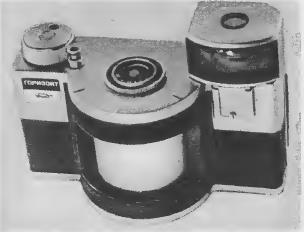
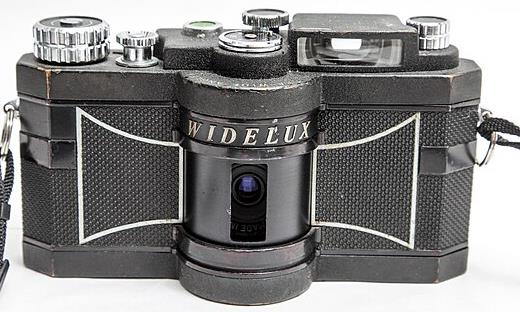 |
The image above is from Wikimedia Commons, licensed under the Creative Commons Attribution-Share Alike 4.0 International License, and is thus available for your use under the same terms. Its author is Kenneth C. Zirkel. |
Taking three-dimensional stereo photographs is not the only unusual thing you can do with 35mm film in a suitable special camera. Shown at left is the Horizon (Gorizont), a Soviet camera from 1967 which took panoramic pictures using the same principle as the Widelux. The Widelux itself, a camera from Japan first available in 1959, is pictured at right. The image shows a Widelux F7, a later model from 1979.
A version of the Widelux that used 120 film instead of 35mm film was also available. Originally, these cameras went by the name Panon, and then later Panon Widelux. Below is an image of an earlier 120 film version of the camera which went by the name Panon.
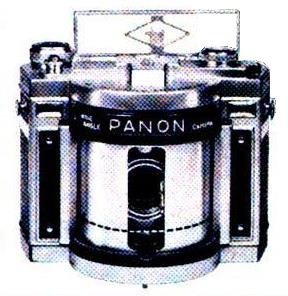
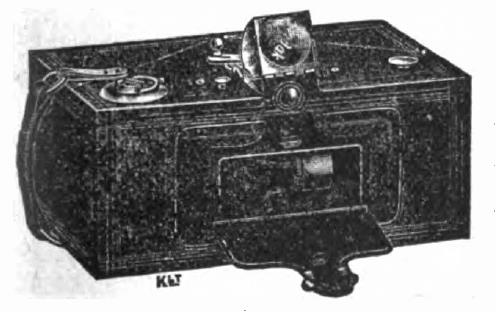 Cameras operating on this basic principle, however, have been available
for some time. There was the Al-Vista camera from 1898 and the Kodak Panoram from 1899.
Cameras operating on this basic principle, however, have been available
for some time. There was the Al-Vista camera from 1898 and the Kodak Panoram from 1899.
At left is a drawing of the Kodak Panoram which shows its lens turned to the photographer's left.
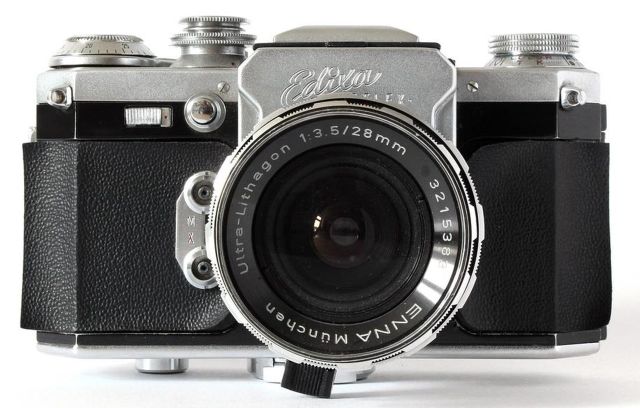 Image by Danny H. from Pixabay |
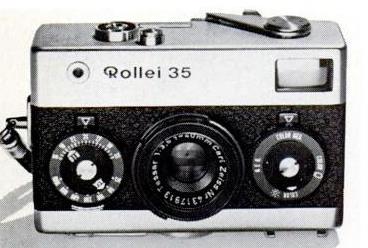
Incidentally, Edixa cameras are products of the West German camera maker Wirgin Kamerawerk, which did not just make stereo cameras. They made rangefinder cameras and reflex cameras as well; they held off a couple of years before exporting their reflex cameras to the United States. There is some interesting background to this company; it was founded in 1920 in Germany; its owners fled to the United States to escape the Nazi regime, returning to Germany to re-establish the company after the war. One of their engineers, Heinz Waaske, ended up leaving for Rollei when Edixa had no interest in producing an innovative design of his that ended up as the Rollei 35. This camera had a simple viewfinder, allowing it to be very compact, and is illustrated on the left.
An Edixa Reflex is illustrated on the right,
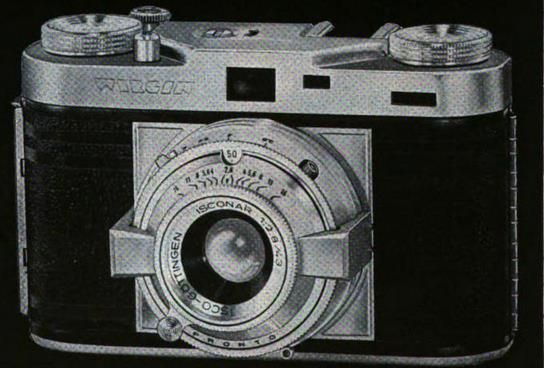
and then an Edixa C rangefinder camera is also illustrated on the right.
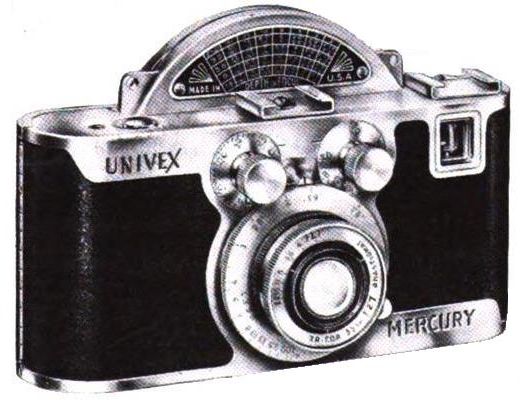
Pictured at left is an American-made camera with a unique appearance. This image is from a 1939 advertisement; this camera, the original Univex Mercury, used 35mm film in special cartridges, but the Univex Mercury II camera, similar in appearance, and available after World War II, used standard 35mm cartridges.
Its chief distinctive feature was that it supported high shutter speeds, as fast as 1/1000 or even 1/1500 second. It was a half-frame camera, and it used a rotary focal-plane shutter. (Yes, it had interchangeable lenses.) It is to accomodate this shutter that the camera has its distinctive curved protrusion at the top.
And, of course, it is to its speedy shutter that it owes its name, Mercury being the "messenger of the gods", and thus being very fast.
Aside from being interesting because of its unique appearance, the Univex Mercury is also notable for having introduced one permanent innovation to 35mm cameras; it was the first camera to have a "hot shoe"; that is, the standardized clip for accessories also contained electrical contacts, so that the camera could switch a circuit on during exposures, thus triggering a flash unit.